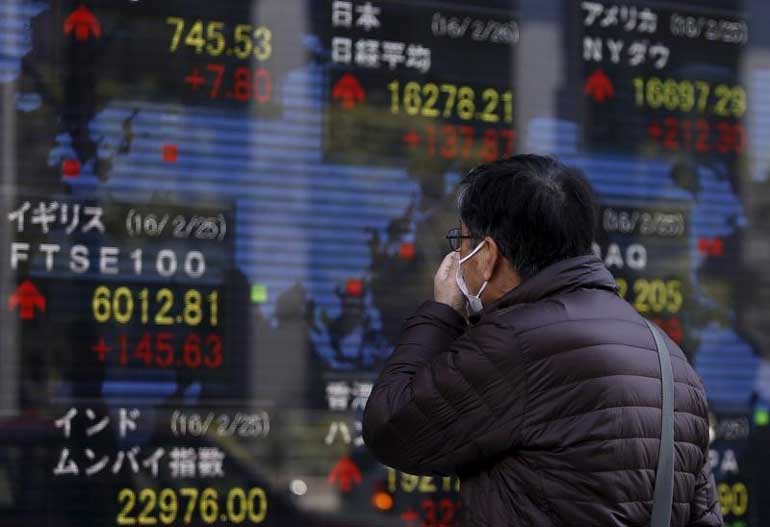Thursday Dec 11, 2025
Thursday Dec 11, 2025
Saturday, 2 April 2016 00:00 - - {{hitsCtrl.values.hits}}
 Gloomy Japanese manufacturing data on Friday ensured a downbeat start to the second quarter, driving stocks and oil lower and supporting safe-haven assets like gold and the Japanese yen.
Gloomy Japanese manufacturing data on Friday ensured a downbeat start to the second quarter, driving stocks and oil lower and supporting safe-haven assets like gold and the Japanese yen.
Still bruised from a turbulent first quarter, investors took their cue from the Japanese data rather than more encouraging figures from China’s manufacturers, before the pivotal US payrolls report later in the day.
Japan’s Nikkei sank 3.5% in its steepest daily fall since mid-February, dragging down shares across Asia. That set the bearish tone for Europe, where the main indices were all down more than 1% in early trading.
The pan-European index of leading 300 shares fell to a one-month low of 1,303 points and US stock futures signaled a decline of around 0.5% when trading opens.
“Normally, we could expect some sort of upside in the wake of better-than-expected Chinese manufacturing numbers. Certainly if they were poor, we’d be looking at a major downdraft in equities,” said Brenda Kelly, head analyst at London Capital Group. “But the focus appears to be on the negative.”
Germany’s DAX and France’s CAC 40 were both down around 1.7%. Britain’s FTSE 100 was down 1.2%.
Financials and insurance stocks were among the biggest decliners, led by a 9% fall in Zurich Insurance, as its shares traded without the attraction of its latest dividend payout.
Earlier in Asia, a profit-dampening rise in the yen and selling by hedge funds for the new financial year weighed on Japanese stocks. But the real blow came from a survey of major manufacturers by the Bank of Japan, which found sentiment at its lowest in nearly three years.
The report crystallised concerns that the BOJ’s shift to negative rates was not working. It also outweighed positive surveys from China that showed factory activity growing for the first time in nine months and a much needed pick-up in services.
MSCI’s broadest index of Asia-Pacific shares outside Japan .MIAPJ0000PUS lost 1.5%.
The tepid start to the second quarter follows a wild first quarter that saw stocks plunge on global growth fears, then rebound as major central banks took ever more aggressive stimulus steps.
The latest twist was this week’s surprisingly dovish tone from Federal Reserve Chair Janet Yellen, which saw investors further scale back expectations for how far and fast U.S. interest rates would rise in coming years.
Fed fund futures currently have one quarter-point increase priced in by December. Yields on two-year Treasury paper were down at one-month lows around 0.73% before edging back up to 0.76%.
Indeed, U.S. Treasuries enjoyed their best quarter in 4 1/2 years. Yields on 10-year notes dropped 50 basis points in the three months to March.
The focus on Friday rests on the U.S. employment report for March. Economists expect an increase of 205,000 jobs, the unemployment rate holding at 4.9% and a rise in average earnings of 0.2% in the month.
“The decisively dovish rhetoric from Yellen this week suggests that today’s U.S. data would have to surprise on the upside in a uniform and very strong fashion in order to provide something more than a temporary lift to the dollar,” Unicredit analysts wrote in a note to clients on Friday.
The greenback suffered its largest quarterly percentage loss in more than five years. The dollar index, which measures it against a basket of major currencies lost 4.1% and on Thursday hit its lowest since mid-October. It was last trading at 94.620, steady on the day.
The euro was stronger at $1.1389 after reaching $1.1411 on Thursday, the first time it rose above $1.1400 in 5 1/2 months. The dollar fell more against the yen, down 0.3% at 112.23 yen, from as high as 113.80 early in the week.
While the weaker dollar had been something of a reprieve for oil, worries about oversupply seemed to dominate in Asia on Friday. US crude fell 0.8% to $38.02 a barrel, while Brent dropped 0.7% to $40.02.
Gold was steadier at $1,231.70 an ounce, after notching up its biggest quarterly gain in nearly 30 years.